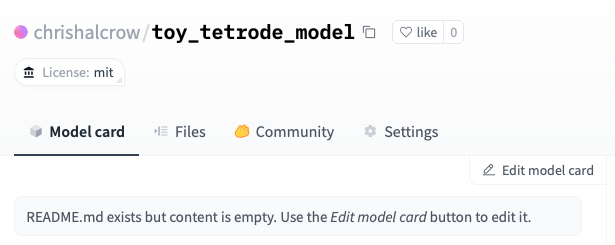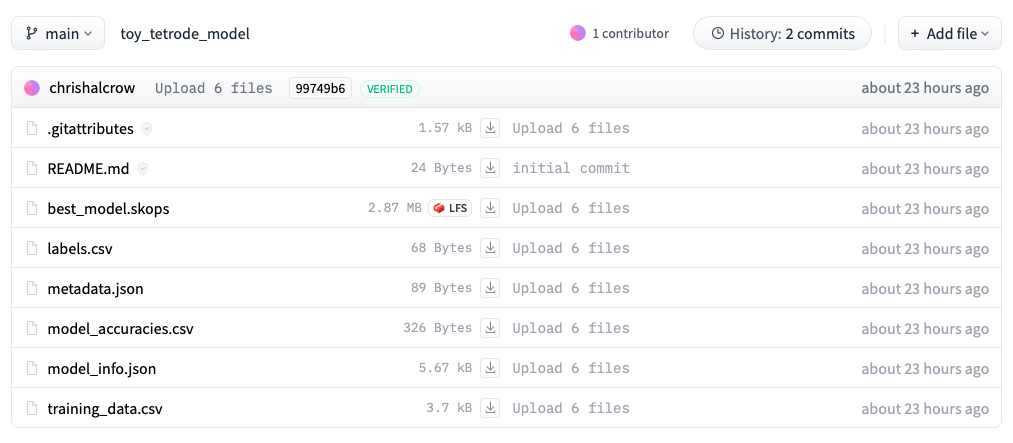Note
Go to the end to download the full example code.
Upload a pipeline to Hugging Face Hub
In this tutorial we will upload a pipeline, trained in SpikeInterface, to the Hugging Face Hub (HFH).
To do this, you first need to train a model. Learn how here!
Hugging Face Hub?
Hugging Face Hub (HFH) is a model sharing platform focused on AI and ML models and datasets.
To upload your own model to HFH, you need to make an account with them.
If you do not want to make an account, you can simply share the model folder with colleagues.
There are also several ways to interaction with HFH: the way we propose here doesn’t use
many of the tools skops and hugging face have developed such as the Card and
hub_utils. Feel free to check those out here.
Prepare your model
The plan is to make a folder with the following file structure
my_model_folder/
my_model_name.skops
model_info.json
training_data.csv
labels.csv
metadata.json
SpikeInterface and HFH don’t require you to keep this folder structure, we just advise it as best practice.
If you’ve used SpikeInterface to train your model, the train_model function auto-generates
most of this data. The only thing missing is the the metadata.json file. The purpose of this
file is to detail how the model was trained, which can help prospective users decide if it
is relevant for them. For example, taking
a model trained on mouse data and applying it to a primate is likely a bad idea (or a
great research paper!). And a model trained using tetrode data might have limited application
on a silcone high-density probes. Hence we suggest saving at least the species, brain areas
and probe information, as is done in the dictionary below. Note that we format the metadata
so that the information
in common with the NWB data format is consistent with it. Since the models can be trained
on several curations, all the metadata fields are lists:
import json
model_metadata = {
"subject_species": ["Mus musculus"],
"brain_areas": ["CA1"],
"probes":
[{
"manufacturer": "IMEc",
"name": "Neuropixels 2.0"
}]
}
with open("my_model_folder/metadata.json", "w") as file:
json.dump(model_metadata, file)
Upload to HuggingFaceHub
We’ll now upload this folder to HFH using the web interface.
First, go to https://huggingface.co/ and make an account. Once you’ve logged in, press
+ then New model or find + New Model in the user menu. You will be asked
to enter a model name, to choose a license for the model and whether the model should
be public or private. After you have made these choices, press Create Model.
You should be on your model’s landing page, whose header looks something like

Click Files, then + Add file then Upload file(s). You can then add your files to the repository. Upload these by pressing Commit changes to main.
You are returned to the Files page, which should look similar to

Let’s add some information about the model for users to see when they go on your model’s
page. Click on Model card then Edit model card. Here is a sample model card for
For a model based on synthetically generated tetrode data,
---
license: mit
---
## Model description
A toy model, trained on toy data generated from spikeinterface.
# Intended use
Used to try out automated curation in SpikeInterface.
# How to Get Started with the Model
This can be used to automatically label a sorting in spikeinterface. Provided you have a `sorting_analyzer`, it is used as follows
` ` ` python (NOTE: you should remove the spaces between each backtick. This is just formatting for the notebook you are reading)
from spikeinterface.curation import auto_label_units
labels = auto_label_units(
sorting_analyzer = sorting_analyzer,
repo_id = "SpikeInterface/toy_tetrode_model",
trust_model=True
)
` ` `
or you can download the entire repositry to `a_folder_for_a_model`, and use
` ` ` python
from spikeinterface.curation import auto_label_units
labels = auto_label_units(
sorting_analyzer = sorting_analyzer,
model_folder = "path/to/a_folder_for_a_model",
trusted = ['numpy.dtype']
)
` ` `
# Authors
Chris Halcrow
You can see the repo with this Model card.
Total running time of the script: (0 minutes 0.000 seconds)